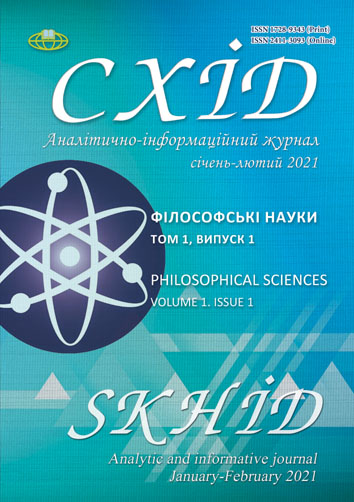THE MAIN APPROACHES TO THE STUDY OF THE CITY PHENOMENON AS A SOCIAL SYSTEM
DOI:
https://doi.org/10.21847/1728-9343.2021.1(1).225768Keywords:
city phenomenon, city as a social system, theoretical experience in the study of urban space, conceptual approaches to the study of the cityAbstract
The article considers issues relevant to contemporary social philosophy regarding theoretical approaches to the study of the urban space phenomenon. The authors show how the social phenomenology of the city is studied within the socio-economic, socio-cultural, socio-ecological and urbanistic approaches. An analysis of the works of representatives of these approaches has made it possible to distinguish several dimensions of the city as a social phenomenon and the trend issues of relevant scientific research. Thus, within the framework of the spatial dimension, the city should be studied as the interaction of physical and social space, giving various configurations of the cultural and spiritual standard of living; the political and administrative dimension focuses the researcher on the study of the activity and interaction of formal organizations and administrative structures in terms of meeting a wide range of human needs. The economic dimension of the city allows considering it as a place of concentration of constantly operating markets, leading to an increase in consumption and the development of a consumer culture of social communities and groups; communication dimension shows it as a synergistic system of intersecting flows of information, under the influence and on the basis of which, complex interaction of social individuals, social institutions and groups is conducted with the aim of producing, using and distributing material and spiritual benefits. From the socio-cultural perspective, the city appears as a symbolic level of the existence of collective ideas, values, social, cultural codes; the so-called “urban myth” is of particular importance here.
Downloads
References
Aristotle (2000). Polityka. Kyiv: Osnovy, 2000. (In Ukrainian).
Bauman, Z. (2008). Gorod strakhov, gorod nadezhd. Logos. 3 (66): 24-53. (In Russian)
Burgess, E. (2002). Rost goroda: vvedeniye v issledovatelskiy proyekt. Lichnost. Kultura. Obshchestvo. IV (1-2): 168-181 (In Russian).
Campanella, T. (1954). Gorod Solntsa (translat. from Lat.). Mos-cow-Leningrad: AN SSSR (In Russian).
Durkheim, E.(1991). O razdelenii obshchestvennogo truda. Mos-cow: Nauka (In Russian).
Horban, O. V. (2011). Grazhdanskoye obshchestvo: ideya i yeye osushchestvleniye. Simferopol: IT ARIAL. (In Russian)
Horban, O.V. (2011). Hromadyanske suspilstvo: ideya ta mekhanizm yiyi zdiysnennya (sotsialno-filosofskyy analiz) (Abstract of Doctor's Thesis). Simferopol, 36 p. (In Ukraini-an)
Karpovets, M. (2014). Misto yak svit lyudskoho buttya. Ostroh, 258 p. (In Ukrainian)
Mumford, L. (2004). What is a City. In: The City Cultures Reader. London; New York : Routledge.
Ortega y Gasset, H. (2008). Vosstaniye mass. Degumanizatsiya iskusstva (Translat. fron Spaine). Moscow: AST: ST Moskva, 347 p. (In Russian).
Park, R. (2002). Gorod kak sotsialnaya laboratoriya. Sotsiolog-icheskoye obozreniye. 3 (2): 3-13 (In Russian).
Plato (2000). Derzhava. Kyiv: Osnovy, 2000. (In Ukrainian).
Simmel, G. (2002). Bolshiye goroda i dukhovnaya zhizn Logos. 3 (34): 23–34 (In Russian)
Sombart, V. (2008). Sobraniye sochineniy v 3 t. (Translat. from Germ.); T. 3. Issledovaniya po istorii razvitiya sovremennogo kapitalizma. Roskosh i kapitalizm. Voyna i kapitalizm. St.Petersburg : Vladimir Dal. (In Russian)
Tönnies, F. (2002). Obshchnost i obshchestvo. Osnovnyye ponyatiya chistoy sotsiologii (Translat. from Germ.). St.Petersburg : Vladimir Dal. (In Russian)
Vodarsky, Ya. Ye. (2006). Issledovaniya po istorii russkogo goroda (fakty, obobshcheniya, aspekty). Moscow: Institut rossiyskoy istorii RAN, 2006. (In Russian).
Weber, M. (2001). Istoriya khozyaystva. Gorod (Translat. from Germ.) Moscow : «KANON-press-TS», «Kuchkovo pole». (In Russian)
Wirth, L. (2005). Izbrannyye raboty po sotsiologii. Sbornik perevodov (Translat. from Engl.). Moscow: INION, 244 p. (In Russian).
Downloads
Published
How to Cite
Issue
Section
License
Copyright (c) 2021 Oleksandr Horban, Anton Nesterovskyi

This work is licensed under a Creative Commons Attribution-NonCommercial-NoDerivatives 4.0 International License.
1. Authors bear responsibility for the accuracy of facts, quotations, numbers and names used.
2. Manuscripts are not sent back.
3. The publisher does not always agree with the authors' opinion.
4. The authors reserve the right to authorship of the work and pass the first publication right of this work to the journal under the terms of a Creative Commons Attribution-NonCommercial-NoDerivatives 4.0 International License. This license allows others to distribute (copy) the published work for non-commercial purposes, provided there is mandatory attribution to its authors and a link to the first publication in our journal.
5. The authors have the right to conclude separate supplement agreements that relate to non-exclusive work distribution in the form in which it has been published by the journal (for example, to upload the work to the online storage of the journal or publish it as part of a monograph), provided that the reference to the first publication of the work in this journal is included.

